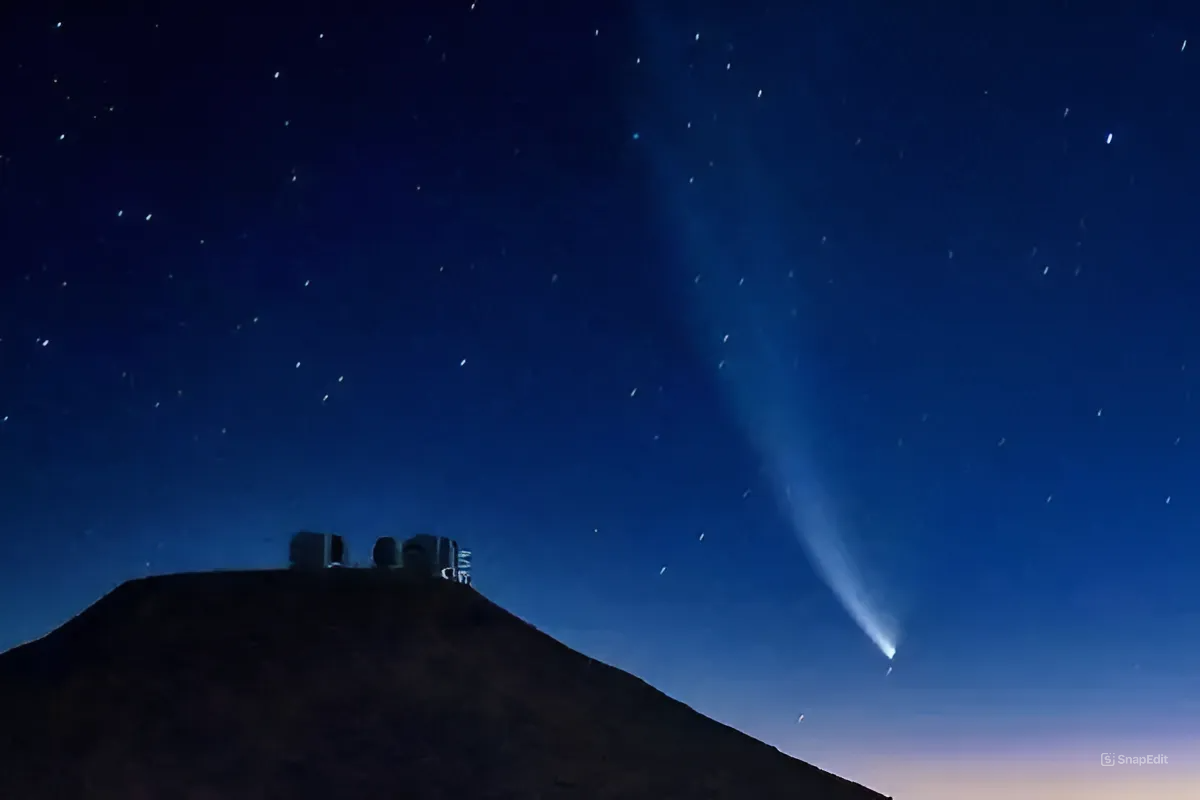
In early 2023, two astronomical observing programs – Tsouchenshan and ATLAS – independently discovered comet C/2023 A3 (Tsouchenshan-Atlas). This object promises to be a spectacle in the sky, visible with the naked eye in the final months of this year, and may be the brightest comet since the passage of McNutt (pictured above) in 2007.
On the night of February 22, 2023, the Atlas Array telescope in South Africa detected a faint object 1.09 billion kilometers away, in the constellation Serpent. Initially, this body was registered at the Zijinshan Observatory in China in January, but it was considered missing due to a lack of tracking observations.
With the rediscovery of ATLAS, the Minor Planet Center (an American organization that concentrates data on asteroids and comets discovered in the solar system) recognized both programs as co-discoverers of the comet, naming it C/2023 A3 (Tsuchinshan-ATLAS).
Images from the Zwicky Transit Facility (ZTF), at Palomar Observatory in California, also captured the object, confirming its cometary nature. These shots revealed a dense coma and a small tail that was only 10 seconds long.
The comet's orbit was calculated based on data from 74 days of observation. It follows a hyperbolic and retrograde orbit, with an inclination of 139 degrees relative to the plane of the ecliptic. Perigee, i.e. its closest approach to the sun, will occur on September 27, 2024, when it will pass 58.5 million kilometers from the star.
When talking about a retrograde orbit, this means that the comet is moving in the opposite direction to that of the planets surrounding the Sun. The hyperbolic path indicates that this comet probably originated in the distant Oort Cloud and will make one pass through the inner solar system. Before being launched into interplanetary space.
On October 12, Comet Tsuchinshan-Atlas will reach its closest approach to Earth, at a distance of approximately 70.8 million kilometers. It will be visible on this day in the early evening during twilight. If the most optimistic forecasts come true, they will be visible to the naked eye and will provide a spectacular sight in the sky.
According to the site astro.vanbuitenen.nl, Which monitors active comets, preliminary calculations suggest that C/2023 A3 could reach magnitude 1.7 on the day of its closest approach, similar to some of the brightest stars. More recent observations suggest the magnitude could be as high as 0.7. On the star size scale, the lower the number, the brighter.

During its closest approach, depending on the amount of gas and dust emitted by the comet, an optical phenomenon called “forward scattering” may occur. This happens when sunlight is refracted by comet dust particles, increasing its brightness by up to 4 magnitudes, potentially making it 40 times brighter.
If this happens, Comet Tsuchinshan-Atlas could shine even brighter than Comet Lovejoy in 2011, making it the brightest comet of the past 15 years.
Although the predictions are promising, comets are unpredictable. There are several factors that can affect the visibility of Comet Tsuchenshan-Atlas. If the object has low cometary activity, it may not shine as brightly. In addition, if it contains more ice than dust, its brightness may be lower than expected. The worst case scenario is for the comet to disintegrate as it approaches the Sun due to the pressure of the ice flying inside it.
Read more:
New observations should improve the object's data
As new observations are made, it will be possible to adjust expectations and get a clearer idea of the organism's behavior. It is expected that the comet “Tsouchenshan-Atlas” will present one of the most beautiful astronomical phenomena that can be seen with the naked eye, which represents an entire generation.
Comets that come from the Oort Cloud, such as the Tsuchenshan Atlas, often have compositions rich in ice and dust. As they approach the Sun, the heat causes these materials to sublimate, creating the bright tails that make comets so stunning. If the Tsuchenshan-Atlas telescope had a large amount of dust, it could reflect sunlight spectacularly, increasing its brightness even further.
Astronomers around the world are watching the comet closely, using a variety of telescopes and instruments to collect additional data. This data will help improve predictions about the comet's brightness and visibility. Amateur and professional observatories are monitoring the Zouchenshan Atlas, hoping to capture detailed images and data that can help us better understand this celestial visitor.
For ordinary observers, the comet is expected to be visible with the naked eye in areas with low light pollution. Using binoculars or amateur telescopes can provide a more detailed view of the comet, with its bright coma and tail extending across the sky.
So, mark your calendar: October 2024 promises to be an unforgettable month for astronomy enthusiasts and anyone who appreciates the wonders of the night sky. Get ready to seek out and witness one of the most amazing events the universe has to offer.

“Web geek. Wannabe thinker. Reader. Freelance travel evangelist. Pop culture aficionado. Certified music scholar.”






